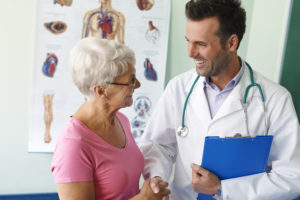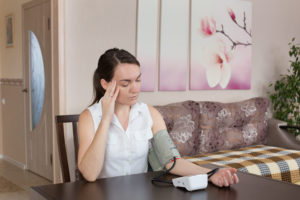
Way too many billions of people worldwide suffer from high blood pressure, also known as hypertension (HTN) and they don’t know it. Some never check their blood pressure while others don’t check it enough. They only have it checked when they go to the doctor’s office.
Furthermore, 45% of individuals with known high blood pressure do not have it within an acceptable range even though they go to the doctor. They are taking prescription blood pressure medication that is failing to control their blood pressure. This might be you.
Elevated or not, you should get into the habit of checking your blood pressure especially if you are overweight, diabetic, drink alcohol, eat a high sodium diet, inactive, smoke, snore, abuse drugs or if you have a family history of high blood pressure or have kidney disease.
A question frequently asked by individual that are ready to take steps to lower their blood pressure is when should I take my blood pressure at home? And its good question. Plan to check your blood pressure when you wake up and before bedtime. Also plan to take it if you had a stressful day or feel symptoms of high or low blood pressure such as head ache or dizziness.
Facts about High Blood Pressure
- 75 million people in the US have high blood pressure
- 81% are unaware that they have it
- 75% are treated and only 51% is adequately controlled
- Occurs more often in blacks at a rate of 41%
- Morbidity and mortality are greater in blacks
- 2/3 of people over 65 have high blood pressure
- High blood pressure increases with age
Statistics show that the most common reason why we visit the doctor is for blood pressure management. Yet still our blood pressure is poorly managed and out of control leaving us at risk for complications.
I Got 99 Problems and Getting a Doctor’s Appointment is One

When you first found out that you were hypertensive with a BP of 150/95, you refused to take the prescription. If being more active can help, then you are on it like white on rice. However, 6 months later your blood pressure did not budge, so you decided to take the blood pressure pill prescribed by your doctor, continue walking and ditched the french fries and hamburgers.
Fast forward now. You feel the same. Well you did not have any symptoms of high blood pressure to begin with. So how do you know if any of this is working? According to the chart in the doctor’s office, by now you should see a decrease in your systolic blood pressure by approximately 15- 20 points. But you have not followed up with your doctor. Now what?
There is no denying that we sometimes have too much on our plate like career and family, but sometimes it also very difficult to get a doctor’s appointment. After waiting two months for your visit, you had to wait 2 more hours to be seen by the doctors.
I appreciate and respect doctors and their expertise, but they are also a part of the problem. Have you ever tried to call your doctor after hours or on the weekend? What kind of help do you get? None!!
Doctors play a role in this problem too because once the office closes for the day, holidays and weekends, they are impossible to reach and sometimes they take days to return a phone call or call in a prescription to the pharmacy. Forget about the physician on call. They never want to make changes to your medication because they don’t know who you are. You are told to wait for the office to reopen and go the emergency room in the case of an emergency.
Self Management of Blood Pressure
Did you know that studies have shown that if you check your blood pressure on a regular basis, you will have better control over it? However, you cannot rely only on your visit to the doctor to have your blood pressure check. Fortunately, you have options including checking it yourself. But don’t be misled. You will still need support and guidance from your physician.
Hopefully, you have a physician that understands the role you will now play to help control your own high blood pressure. He/She will guide you on how to take, track and report your blood pressure readings. You might even receive instructions on how to adjust your medication base on the readings.
The only way to know if your lifestyle changes and blood pressure medication is working is to take your blood pressure regularly. Depending on where you live, you can also have your blood pressure taken at the pharmacy. Some churches and community centers offer blood pressure screening. Look for one in your area.
If your blood pressure is elevated only when checked in the doctor’s office, then you might have a condition called white coat hypertension. Being able to check your blood pressure outside of the doctor office will help the doctor decide if you have true hypertension. If it is still then your are most like hypertensive.
However, the reverse can also be true, your blood pressure can be normal at the doctor’s office but high at home. Therefore, having the right tools and resources to check your blood pressure regularly is crucial for you over all health and well-being.
Tricks of the Trade from a Nurse

Experts recommend that you check your blood pressure two times per day. Take your blood pressure 2-3 times, one minute a part as follows:
- Relax for 5 mins before checking
- Sit in a chair with your back supported
- Uncross legs
- Feet flat on the ground or supported by a foot stool
- Relax Arm at the level of the heart on a hard surface
- No talking, text, watching TV or activity
- No caffeine, exercise, or smoking 30mins before checking.
- Empty bladder
- Take your blood pressure at the same time everyday
BP Devices
- Automated (recommended]
- Manual
Select the right site
- Upper arm (recommended)
- Wrist
- Thigh
- Lower Leg
Select the Right Arm Circumference Cuff Size
- 22-26cm Small Adult
- 27-34cm Adult
- 35—44cm Large Adult
- 45-52cm Adult Thigh
Select a device that is Validated and Certified by one of the following;
- Association for the Advancement of Medical Instruments
- British Hypertension Society
- European Society of Hypertension
Somebody Please Call 911 or Your Doctor or Go to the Emergency Room
Now that you understand the importance of taking your blood pressure and you learned the skills of proper blood pressure measurement the next step is to know when to call 911.
If you experience any of the below symptoms, seek medical attention immediately.
- Difficulty breathing
- Nosebleed
- Sudden difficulty speaking and understanding
- Sudden loss of vision or vision problems
- Sudden weakness in one arm, one leg or one side of the face
- Sudden spinning sensation in head
- Sudden severe headache
- Sudden chest or arm pain
- Sudden Confusion
- Several high blood pressure reading
- SBP greater than 180 or DBP greater than 110
Because I don’t know your circumstances, I cannot advice you on which action to take if you are experiencing any of the above symptoms. I am very aware that we don’t all have access to the same healthcare. But you should know that something serious might be happening to you and you need to seek help.
If you are diagnosed with hypertension but despite taking medications, your blood pressure is still high then start to monitor your blood pressure. You will increase your chances of getting it within normal range.
If you are overweight, diabetic, smoke , stressed, eat and drink too much of the wrong things then you will develop high blood pressure. No questions ask. You should also start checking your blood pressure too and get a head of it.
The most effective way for you to be successful with checking your blood pressure often is to have your own equipment at home. Select a machine that is easy to use. Preferably one that stores your information . This way you can keep track and report your measurements to your doctor. Taking your blood pressure is a quick and painless process. With the right mindset, support and tools you will be on your way towards good health.
